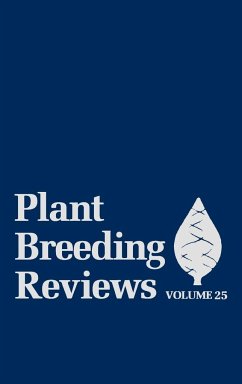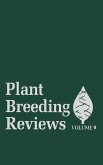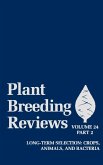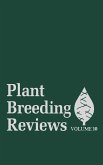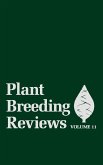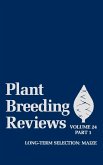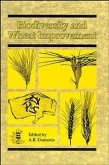Plant Breeding Reviews, Volume 25
Herausgeber: Janick, Jules
Plant Breeding Reviews, Volume 25
Herausgeber: Janick, Jules
- Gebundenes Buch
- Merkliste
- Auf die Merkliste
- Bewerten Bewerten
- Teilen
- Produkt teilen
- Produkterinnerung
- Produkterinnerung
Plant Breeding Reviews presents state-of-the-art reviews on plant genetics and the breeding of all types of crops by both traditional means and molecular methods. Many of the crops widely grown today stem from a very narrow genetic base. Understanding and preserving crop genetic resources is vital to the security of food systems worldwide.
Andere Kunden interessierten sich auch für
![Plant Breeding Reviews, Volume 9 Plant Breeding Reviews, Volume 9]() Plant Breeding Reviews, Volume 9417,99 €
Plant Breeding Reviews, Volume 9417,99 €![Plant Breeding Reviews, Volume 24, Part 2 Plant Breeding Reviews, Volume 24, Part 2]() Plant Breeding Reviews, Volume 24, Part 2417,99 €
Plant Breeding Reviews, Volume 24, Part 2417,99 €![Plant Breeding Reviews, Volume 10 Plant Breeding Reviews, Volume 10]() Plant Breeding Reviews, Volume 10417,99 €
Plant Breeding Reviews, Volume 10417,99 €![Plant Breeding Reviews, Volume 11 Plant Breeding Reviews, Volume 11]() Plant Breeding Reviews, Volume 11417,99 €
Plant Breeding Reviews, Volume 11417,99 €![Plant Breeding Reviews, Volume 24, Part 1 Plant Breeding Reviews, Volume 24, Part 1]() Plant Breeding Reviews, Volume 24, Part 1417,99 €
Plant Breeding Reviews, Volume 24, Part 1417,99 €![Biodiversity and Wheat Improvement Biodiversity and Wheat Improvement]() Biodiversity and Wheat Improvement844,99 €
Biodiversity and Wheat Improvement844,99 €![Wastewater Reuse, Volume 1 Wastewater Reuse, Volume 1]() Kader GaidWastewater Reuse, Volume 1172,99 €
Kader GaidWastewater Reuse, Volume 1172,99 €-
-
-
Plant Breeding Reviews presents state-of-the-art reviews on plant genetics and the breeding of all types of crops by both traditional means and molecular methods. Many of the crops widely grown today stem from a very narrow genetic base. Understanding and preserving crop genetic resources is vital to the security of food systems worldwide.
Hinweis: Dieser Artikel kann nur an eine deutsche Lieferadresse ausgeliefert werden.
Hinweis: Dieser Artikel kann nur an eine deutsche Lieferadresse ausgeliefert werden.
Produktdetails
- Produktdetails
- Verlag: Wiley
- Volume 25 edition
- Seitenzahl: 354
- Erscheinungstermin: 28. Februar 2005
- Englisch
- Abmessung: 235mm x 157mm x 25mm
- Gewicht: 731g
- ISBN-13: 9780471666936
- ISBN-10: 0471666939
- Artikelnr.: 23013301
- Herstellerkennzeichnung
- Libri GmbH
- Europaallee 1
- 36244 Bad Hersfeld
- gpsr@libri.de
- Verlag: Wiley
- Volume 25 edition
- Seitenzahl: 354
- Erscheinungstermin: 28. Februar 2005
- Englisch
- Abmessung: 235mm x 157mm x 25mm
- Gewicht: 731g
- ISBN-13: 9780471666936
- ISBN-10: 0471666939
- Artikelnr.: 23013301
- Herstellerkennzeichnung
- Libri GmbH
- Europaallee 1
- 36244 Bad Hersfeld
- gpsr@libri.de
Jules Janick is the James Troop Distinguished Professor of Horticulture at Purdue University in West Lafayette, IN, USA.
List of Contributors.
1. Dedication: Stanley J. Peloquin.
Potato Geneticist and Cytogeneticist (Rodomiro Ortiz, Luigi Frusciante, and
Domenico Carputo).
2. Politics of Plant Breeding (Cary Fowler and Richard L. Lower).
I. Introduction.
II. Germplasm, Plant Breeding, and the Fight for Rights.
III. The Debate Over Biotechnology.
IV. Plant Breeders' Choices.
Literature Cited.
3. Doubled Haploids in Genetics and Plant Breeding (Brian P. Forster and
William T. B. Thomas).
I. Introduction.
II. Doubled Haploid Technology.
III. Doubled Haploid Populations in Genetics.
IV. Doubled Haploids in Breeding.
V. Prospects.
Literature Cited.
4. Biochemistry and Genetics of Flower Color (R. J. Griesbach).
I. Introduction.
II. Flavonoid Chemistry.
III. Anthocyanin Biosynthesis.
IV. Mendelian Inheritance.
V. Transgene Technology.
Literature Cited.
5. The Influence of Mitochondrial Genetics on Crop Breeding Strategies (
Sally A. Mackenzie).
I. Introduction.
II. Structure of the Mitochondrial Genome in Plants.
III. Cytoplasmic Male Sterility.
IV. Occurrence and Developmental Implications of Nuclear-Cytoplasmic
Incompatibility.
V. Some Implications of Cytoplasmic Genetics for the Plant Breeder.
Literature Cited.
6. Genetic and Cytoplasmic-Nuclear Male Sterility in Sorghum (Belum V. S.
Reddy, S. Ramesh, and Rodomiro Ortiz).
I. Introduction.
II. Genetic Male Sterility (GMS).
III. Cytoplasmic-Nuclear Male Sterility (CMS).
IV. Molecular Characterization of Cytoplasms.
V. DNA Polymorphism and Mapping Restorer Genes.
VI. Factors Influencing CMS Systems Use.
VII. Diversification of CMS Systems.
VIII. Heterosis and Hybrid Development.
IX. Conclusion.
Literature Cited.
7. Improving Drought Tolerance in Maize (T. Barker, H. Campos, M. Cooper,
D. Dolan, G. Edmeades, J. Habben, J. Schussler, D. Wright, and C.
Zinselmeier).
I. Introduction.
II. Physiology of the Response of Maize Under Drought.
III. Experimental Methods.
IV. Applied Breeding Methods.
V. Molecular Breeding.
VI. Conclusions.
Literature Cited.
8. The Origins of Fruits, Fruit Growing, and Fruit Breeding (Jules Janick
).
I. Introduction.
II. The Horticultural Arts.
III. Origin, Domestication, and Early Culture of Fruit Crops.
IV. Genetic Changes and Cultural Factors in Domestication.
Literature Cited.
Subject Index.
Cumulative Subject Index.
Cumulative Contributor Index.
1. Dedication: Stanley J. Peloquin.
Potato Geneticist and Cytogeneticist (Rodomiro Ortiz, Luigi Frusciante, and
Domenico Carputo).
2. Politics of Plant Breeding (Cary Fowler and Richard L. Lower).
I. Introduction.
II. Germplasm, Plant Breeding, and the Fight for Rights.
III. The Debate Over Biotechnology.
IV. Plant Breeders' Choices.
Literature Cited.
3. Doubled Haploids in Genetics and Plant Breeding (Brian P. Forster and
William T. B. Thomas).
I. Introduction.
II. Doubled Haploid Technology.
III. Doubled Haploid Populations in Genetics.
IV. Doubled Haploids in Breeding.
V. Prospects.
Literature Cited.
4. Biochemistry and Genetics of Flower Color (R. J. Griesbach).
I. Introduction.
II. Flavonoid Chemistry.
III. Anthocyanin Biosynthesis.
IV. Mendelian Inheritance.
V. Transgene Technology.
Literature Cited.
5. The Influence of Mitochondrial Genetics on Crop Breeding Strategies (
Sally A. Mackenzie).
I. Introduction.
II. Structure of the Mitochondrial Genome in Plants.
III. Cytoplasmic Male Sterility.
IV. Occurrence and Developmental Implications of Nuclear-Cytoplasmic
Incompatibility.
V. Some Implications of Cytoplasmic Genetics for the Plant Breeder.
Literature Cited.
6. Genetic and Cytoplasmic-Nuclear Male Sterility in Sorghum (Belum V. S.
Reddy, S. Ramesh, and Rodomiro Ortiz).
I. Introduction.
II. Genetic Male Sterility (GMS).
III. Cytoplasmic-Nuclear Male Sterility (CMS).
IV. Molecular Characterization of Cytoplasms.
V. DNA Polymorphism and Mapping Restorer Genes.
VI. Factors Influencing CMS Systems Use.
VII. Diversification of CMS Systems.
VIII. Heterosis and Hybrid Development.
IX. Conclusion.
Literature Cited.
7. Improving Drought Tolerance in Maize (T. Barker, H. Campos, M. Cooper,
D. Dolan, G. Edmeades, J. Habben, J. Schussler, D. Wright, and C.
Zinselmeier).
I. Introduction.
II. Physiology of the Response of Maize Under Drought.
III. Experimental Methods.
IV. Applied Breeding Methods.
V. Molecular Breeding.
VI. Conclusions.
Literature Cited.
8. The Origins of Fruits, Fruit Growing, and Fruit Breeding (Jules Janick
).
I. Introduction.
II. The Horticultural Arts.
III. Origin, Domestication, and Early Culture of Fruit Crops.
IV. Genetic Changes and Cultural Factors in Domestication.
Literature Cited.
Subject Index.
Cumulative Subject Index.
Cumulative Contributor Index.
List of Contributors.
1. Dedication: Stanley J. Peloquin.
Potato Geneticist and Cytogeneticist (Rodomiro Ortiz, Luigi Frusciante, and
Domenico Carputo).
2. Politics of Plant Breeding (Cary Fowler and Richard L. Lower).
I. Introduction.
II. Germplasm, Plant Breeding, and the Fight for Rights.
III. The Debate Over Biotechnology.
IV. Plant Breeders' Choices.
Literature Cited.
3. Doubled Haploids in Genetics and Plant Breeding (Brian P. Forster and
William T. B. Thomas).
I. Introduction.
II. Doubled Haploid Technology.
III. Doubled Haploid Populations in Genetics.
IV. Doubled Haploids in Breeding.
V. Prospects.
Literature Cited.
4. Biochemistry and Genetics of Flower Color (R. J. Griesbach).
I. Introduction.
II. Flavonoid Chemistry.
III. Anthocyanin Biosynthesis.
IV. Mendelian Inheritance.
V. Transgene Technology.
Literature Cited.
5. The Influence of Mitochondrial Genetics on Crop Breeding Strategies (
Sally A. Mackenzie).
I. Introduction.
II. Structure of the Mitochondrial Genome in Plants.
III. Cytoplasmic Male Sterility.
IV. Occurrence and Developmental Implications of Nuclear-Cytoplasmic
Incompatibility.
V. Some Implications of Cytoplasmic Genetics for the Plant Breeder.
Literature Cited.
6. Genetic and Cytoplasmic-Nuclear Male Sterility in Sorghum (Belum V. S.
Reddy, S. Ramesh, and Rodomiro Ortiz).
I. Introduction.
II. Genetic Male Sterility (GMS).
III. Cytoplasmic-Nuclear Male Sterility (CMS).
IV. Molecular Characterization of Cytoplasms.
V. DNA Polymorphism and Mapping Restorer Genes.
VI. Factors Influencing CMS Systems Use.
VII. Diversification of CMS Systems.
VIII. Heterosis and Hybrid Development.
IX. Conclusion.
Literature Cited.
7. Improving Drought Tolerance in Maize (T. Barker, H. Campos, M. Cooper,
D. Dolan, G. Edmeades, J. Habben, J. Schussler, D. Wright, and C.
Zinselmeier).
I. Introduction.
II. Physiology of the Response of Maize Under Drought.
III. Experimental Methods.
IV. Applied Breeding Methods.
V. Molecular Breeding.
VI. Conclusions.
Literature Cited.
8. The Origins of Fruits, Fruit Growing, and Fruit Breeding (Jules Janick
).
I. Introduction.
II. The Horticultural Arts.
III. Origin, Domestication, and Early Culture of Fruit Crops.
IV. Genetic Changes and Cultural Factors in Domestication.
Literature Cited.
Subject Index.
Cumulative Subject Index.
Cumulative Contributor Index.
1. Dedication: Stanley J. Peloquin.
Potato Geneticist and Cytogeneticist (Rodomiro Ortiz, Luigi Frusciante, and
Domenico Carputo).
2. Politics of Plant Breeding (Cary Fowler and Richard L. Lower).
I. Introduction.
II. Germplasm, Plant Breeding, and the Fight for Rights.
III. The Debate Over Biotechnology.
IV. Plant Breeders' Choices.
Literature Cited.
3. Doubled Haploids in Genetics and Plant Breeding (Brian P. Forster and
William T. B. Thomas).
I. Introduction.
II. Doubled Haploid Technology.
III. Doubled Haploid Populations in Genetics.
IV. Doubled Haploids in Breeding.
V. Prospects.
Literature Cited.
4. Biochemistry and Genetics of Flower Color (R. J. Griesbach).
I. Introduction.
II. Flavonoid Chemistry.
III. Anthocyanin Biosynthesis.
IV. Mendelian Inheritance.
V. Transgene Technology.
Literature Cited.
5. The Influence of Mitochondrial Genetics on Crop Breeding Strategies (
Sally A. Mackenzie).
I. Introduction.
II. Structure of the Mitochondrial Genome in Plants.
III. Cytoplasmic Male Sterility.
IV. Occurrence and Developmental Implications of Nuclear-Cytoplasmic
Incompatibility.
V. Some Implications of Cytoplasmic Genetics for the Plant Breeder.
Literature Cited.
6. Genetic and Cytoplasmic-Nuclear Male Sterility in Sorghum (Belum V. S.
Reddy, S. Ramesh, and Rodomiro Ortiz).
I. Introduction.
II. Genetic Male Sterility (GMS).
III. Cytoplasmic-Nuclear Male Sterility (CMS).
IV. Molecular Characterization of Cytoplasms.
V. DNA Polymorphism and Mapping Restorer Genes.
VI. Factors Influencing CMS Systems Use.
VII. Diversification of CMS Systems.
VIII. Heterosis and Hybrid Development.
IX. Conclusion.
Literature Cited.
7. Improving Drought Tolerance in Maize (T. Barker, H. Campos, M. Cooper,
D. Dolan, G. Edmeades, J. Habben, J. Schussler, D. Wright, and C.
Zinselmeier).
I. Introduction.
II. Physiology of the Response of Maize Under Drought.
III. Experimental Methods.
IV. Applied Breeding Methods.
V. Molecular Breeding.
VI. Conclusions.
Literature Cited.
8. The Origins of Fruits, Fruit Growing, and Fruit Breeding (Jules Janick
).
I. Introduction.
II. The Horticultural Arts.
III. Origin, Domestication, and Early Culture of Fruit Crops.
IV. Genetic Changes and Cultural Factors in Domestication.
Literature Cited.
Subject Index.
Cumulative Subject Index.
Cumulative Contributor Index.

